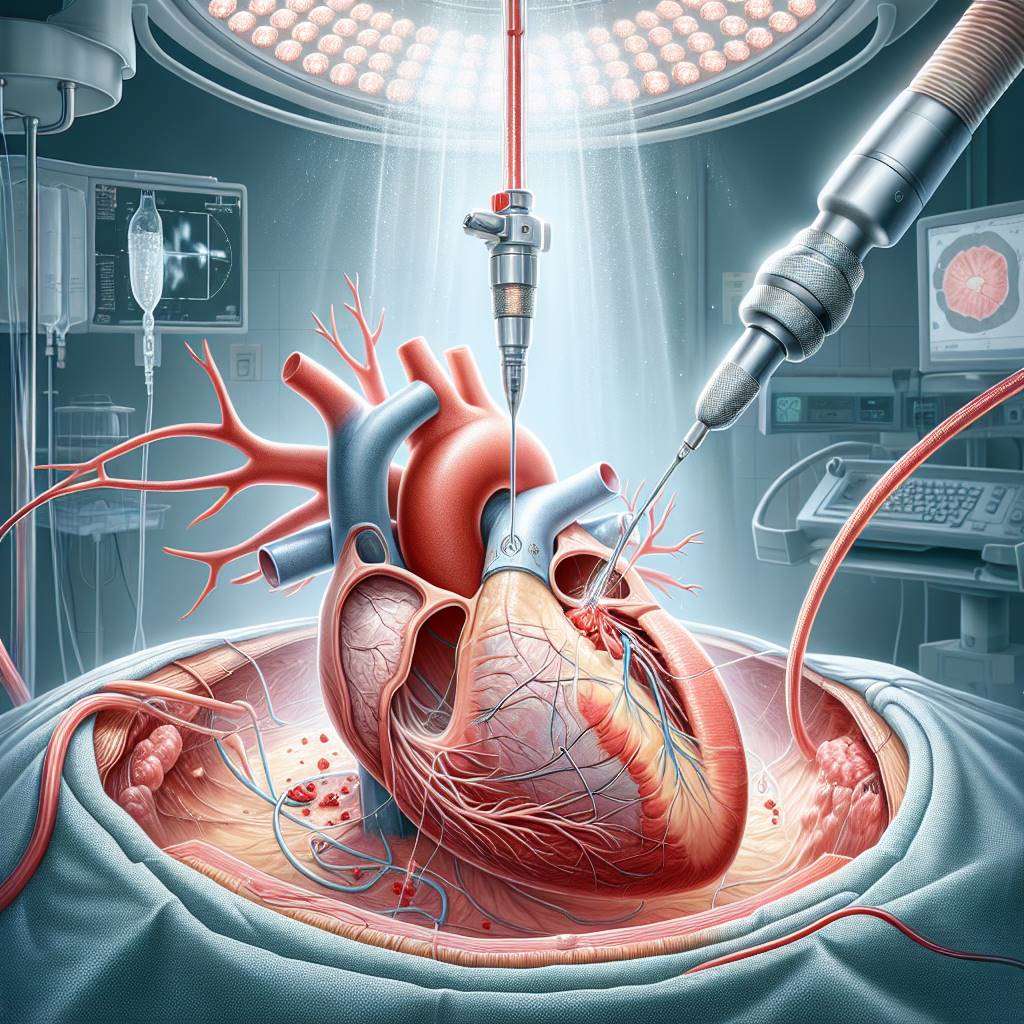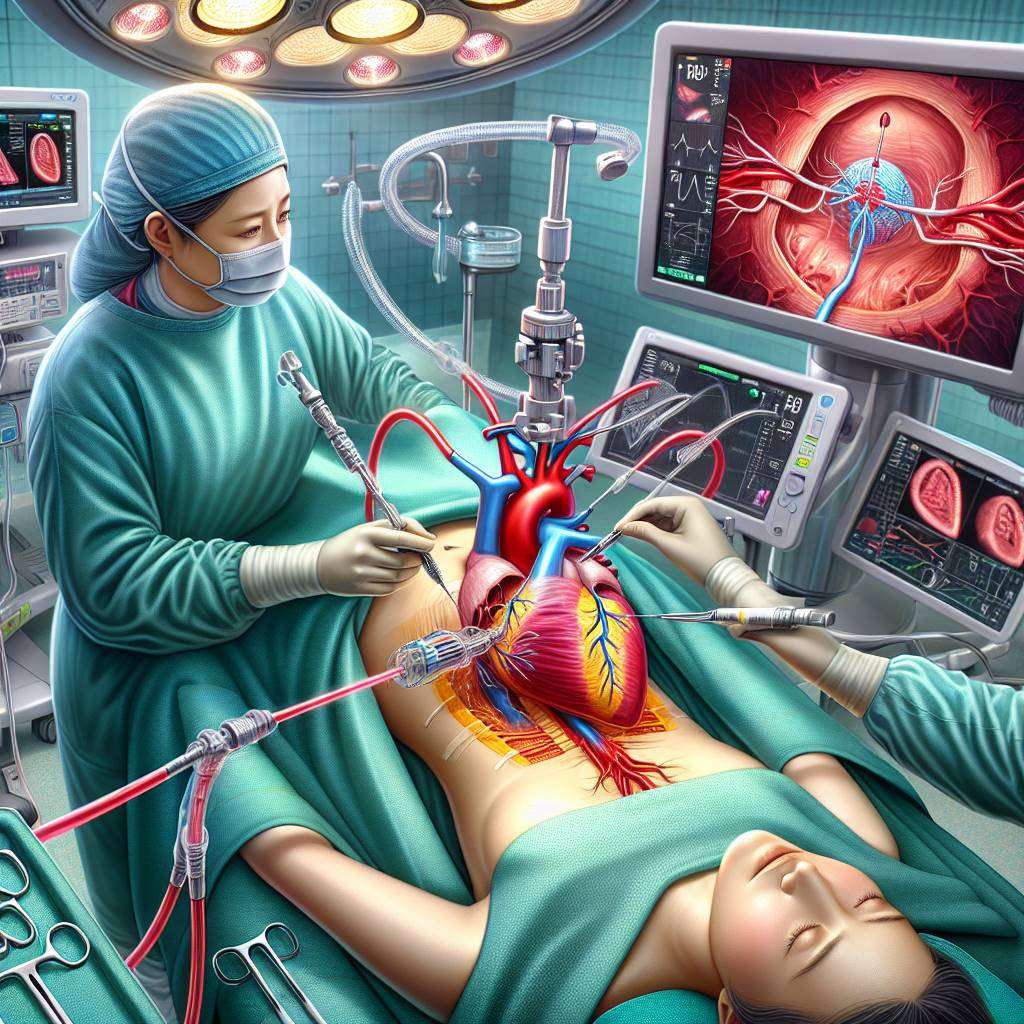Transcatheter Edge-to-Edge Repair (TEER) is a minimally invasive procedure designed to treat mitral valve regurgitation, a condition where the mitral valve does not close properly, causing blood to flow backward into the heart. Unlike traditional surgical methods, TEER offers a less invasive alternative, making it suitable for patients who are at high risk for open-heart surgery.
TEER is often compared to Transcatheter Mitral Valve Replacement (TMVR), another advanced treatment for mitral valve disease. While both procedures aim to improve heart function, they differ significantly in approach and patient suitability. Understanding these differences is crucial for patients and healthcare providers to make informed decisions about treatment options.
What Is Transcatheter Edge-to-Edge Repair (TEER)?
Transcatheter Edge-to-Edge Repair (TEER) is a cutting-edge procedure used to treat mitral valve regurgitation. This condition occurs when the mitral valve fails to close completely, leading to blood leakage and reduced heart efficiency. TEER involves the use of a catheter to place a clip on the mitral valve, helping it close more effectively and restore normal blood flow.
This minimally invasive technique is performed through a small incision, typically in the groin, and does not require open-heart surgery. TEER is particularly beneficial for patients who are considered high-risk for traditional surgical procedures due to age or underlying health conditions. By improving heart function, TEER can significantly enhance the quality of life for patients with severe mitral valve disease.

How TEER Differs from Traditional TMVR Procedures
While both TEER and Transcatheter Mitral Valve Replacement (TMVR) are advanced treatments for mitral valve disease, they differ in their approach and application. TEER focuses on repairing the existing mitral valve by clipping its leaflets together, whereas TMVR involves replacing the entire valve with a prosthetic one.
TEER is less invasive compared to TMVR and is often preferred for patients with severe mitral regurgitation who are not candidates for valve replacement. TMVR, on the other hand, is typically recommended for patients with more complex valve damage or when repair is not feasible. These differences make TEER a more suitable option for certain high-risk patients.
TEER vs TMVR: Key Benefits and Limitations
Both TEER and TMVR have unique advantages and limitations. TEER offers a minimally invasive approach, shorter recovery time, and reduced procedural risks, making it ideal for elderly or high-risk patients. However, it may not be effective for patients with extensive valve damage.
TMVR, while more invasive, provides a complete solution by replacing the damaged valve. This can be beneficial for patients with severe structural abnormalities. Below is a comparison of the two procedures:
| Feature |
TEER |
TMVR |
| Invasiveness |
Minimally invasive |
More invasive |
| Recovery Time |
Shorter |
Longer |
| Suitability |
High-risk patients |
Patients with severe valve damage |
Who Is a Candidate for TEER Treatment?
TEER is primarily recommended for patients with severe mitral regurgitation who are not suitable candidates for open-heart surgery. This includes elderly individuals, those with multiple comorbidities, or patients with a history of heart surgery. The procedure is also ideal for patients who require a less invasive option due to their overall health condition.
Before undergoing TEER, patients are evaluated through imaging tests like echocardiography to assess the severity of their valve disease. A multidisciplinary team of cardiologists and surgeons determines the best course of action based on the patient’s specific needs. TEER offers hope to many patients who might otherwise have limited treatment options.
Understanding the TEER Procedure Step by Step
The TEER procedure involves several key steps to ensure its success. First, the patient is placed under general anesthesia, and a catheter is inserted through a vein in the groin. Using advanced imaging techniques, the catheter is guided to the mitral valve.
Once in position, a clip is deployed to bring the valve leaflets together, reducing regurgitation. The procedure typically takes a few hours, and patients can expect a shorter hospital stay compared to traditional surgery. Post-procedure care includes regular follow-ups to monitor heart function and ensure the clip remains effective.
- Preparation: Imaging tests and anesthesia
- Catheter insertion and navigation
- Clip placement on the mitral valve
- Post-procedure monitoring and recovery
TEER for Mitral Regurgitation: A Game-Changing Approach
Transcatheter Edge-to-Edge Repair (TEER) is a minimally invasive procedure designed to treat mitral regurgitation, a condition where the mitral valve does not close properly, causing blood to flow backward into the heart. Unlike traditional open-heart surgery, TEER uses a catheter-based approach to repair the valve without the need for large incisions.
This innovative technique is particularly beneficial for patients who are at high risk for surgical complications. By using a clip to bring the edges of the mitral valve together, TEER effectively reduces the regurgitation and improves heart function. It is a preferred option for elderly patients or those with comorbidities such as heart failure or chronic kidney disease.

Comparing TEER and TMVR: Which Is Right for You?
Both TEER and Transcatheter Mitral Valve Replacement (TMVR) are advanced treatments for mitral valve diseases, but they differ significantly in their approach and suitability. TEER focuses on repairing the existing valve by clipping its edges, while TMVR involves replacing the damaged valve with a prosthetic one.
TEER is ideal for patients with moderate to severe mitral regurgitation who are not candidates for surgery due to age or other health conditions. TMVR, on the other hand, is often recommended for patients with severely damaged valves that cannot be repaired effectively.
| Feature |
TEER |
TMVR |
| Procedure Type |
Repair |
Replacement |
| Invasiveness |
Minimally invasive |
Moderately invasive |
| Recovery Time |
Shorter |
Longer |
Risks and Complications of TEER You Should Know
While TEER is a relatively safe procedure, it is not without risks. Some potential complications include bleeding at the catheter insertion site, infection, or damage to the blood vessels. Rarely, patients may experience device-related issues such as clip detachment or incomplete closure of the valve.
Other risks include stroke, irregular heart rhythms, or worsening of the mitral regurgitation. However, these complications are uncommon and are often outweighed by the benefits of the procedure. It is essential to discuss your medical history and potential risks with your cardiologist before undergoing TEER.
Advancements in technology and experienced medical teams have significantly reduced the likelihood of complications, making TEER a safer option for many patients.
How TEER Improves Quality of Life for Patients
TEER has been shown to significantly enhance the quality of life for patients suffering from mitral regurgitation. By reducing the backward flow of blood, the procedure alleviates symptoms such as fatigue, shortness of breath, and swelling in the legs. This allows patients to return to daily activities with greater ease.
Moreover, TEER improves heart function, reducing the strain on the heart and lowering the risk of complications like heart failure. Many patients report better exercise tolerance and an overall improvement in their physical and emotional well-being after the procedure.
For individuals who were previously ineligible for surgery, TEER offers a life-changing alternative that restores their independence and vitality.
TEER Success Rates: What Recent Studies Reveal
Recent studies have demonstrated high success rates for TEER in treating mitral regurgitation. Clinical trials show that over 90% of patients experience significant improvement in their symptoms and heart function within a few months of the procedure.
Long-term data also indicates that TEER reduces hospitalizations for heart failure and improves survival rates in high-risk patients. The procedure's minimally invasive nature contributes to faster recovery times and fewer complications compared to traditional surgery.
As technology continues to advance, the success rates of TEER are expected to improve further, making it a reliable and effective option for managing mitral valve diseases.
Recovery After TEER: What to Expect Post-Procedure
After undergoing Transcatheter Edge-to-Edge Repair (TEER), patients typically experience a shorter recovery time compared to traditional surgical procedures. TEER is a minimally invasive technique, which means less trauma to the body and quicker healing.
Most patients are discharged within 1–2 days and can resume light activities within a week. However, it is crucial to follow your doctor’s advice regarding physical activity and medications. Regular follow-ups are essential to monitor the heart’s function and ensure the mitral valve repair is successful.
Common post-procedure instructions include:
- Taking prescribed blood thinners to prevent clot formation.
- Monitoring for symptoms like fatigue or shortness of breath.
- Maintaining a heart-healthy diet and lifestyle.
Patients should immediately report any signs of complications, such as chest pain or irregular heartbeat, to their healthcare provider.

TEER Technology: Innovations in Heart Valve Repair
TEER technology represents a significant advancement in the treatment of heart valve diseases, particularly for patients with mitral regurgitation. Unlike traditional open-heart surgery, TEER uses a catheter-based approach to repair the valve without the need for large incisions.
The procedure involves the use of a clip device that is delivered through a catheter to the heart. This clip brings the edges of the mitral valve together, reducing the backflow of blood and improving heart function. The precision of this technology ensures minimal damage to surrounding tissues.
TEER is especially beneficial for patients who are at high risk for surgery due to age or other medical conditions. Its minimally invasive nature reduces hospital stays and recovery times, making it a preferred choice for many.
Cost of TEER vs TMVR: What Patients Should Know
The cost of Transcatheter Edge-to-Edge Repair (TEER) and Transcatheter Mitral Valve Replacement (TMVR) can vary significantly based on factors like hospital facilities, expertise, and patient-specific needs. TEER is often more affordable than TMVR due to its less complex nature.
While TMVR involves replacing the entire mitral valve, TEER focuses on repairing the existing valve, which can reduce procedural costs. However, both treatments require advanced technology and skilled specialists, which can influence the overall expense.
Here’s a comparison:
| Aspect |
TEER |
TMVR |
| Procedure Type |
Repair |
Replacement |
| Cost |
Lower |
Higher |
| Recovery Time |
Shorter |
Longer |
Patients should consult their cardiologist to understand the best option based on their condition and financial considerations.
TEER Procedure in India: Availability and Expertise
India has emerged as a hub for advanced cardiac care, including the TEER procedure. Leading hospitals in metropolitan cities like Delhi, Mumbai, and Chennai offer this innovative treatment, supported by state-of-the-art technology and experienced cardiologists.
The availability of TEER in India has made it accessible to a broader population, including international patients seeking affordable yet high-quality care. Indian healthcare providers are known for their expertise in minimally invasive procedures, ensuring successful outcomes for patients with mitral valve disease.
Additionally, the cost of TEER in India is significantly lower compared to Western countries, making it an attractive option for medical tourism. Patients are advised to choose accredited hospitals and consult specialists with extensive experience in performing TEER.
Future of TEER: Advancements in Cardiac Care
The future of Transcatheter Edge-to-Edge Repair (TEER) is promising, with ongoing advancements aimed at improving patient outcomes and expanding its applicability. Researchers are working on enhancing the durability and efficiency of the clip devices used in the procedure.
One exciting development is the integration of artificial intelligence (AI) in imaging and procedural planning, which can improve precision and reduce complications. Additionally, newer generations of TEER devices are being designed to treat a wider range of valvular heart diseases.
As technology evolves, TEER is expected to become a standard treatment for patients who are ineligible for surgery. Its minimally invasive nature and proven effectiveness make it a cornerstone of modern cardiac care.
Transcatheter Edge-to-Edge Repair (TEER) Top Doctors in India
Dr. Naresh Trehan, Chairman and Managing Director of Medanta - The Medicity, Gurugram, is a globally recognized cardiac surgeon with over 40 years of experience. He holds an MCh in Cardiothoracic Surgery and has performed thousands of successful cardiac procedures. Another expert is Dr. Ashok Seth, Chairman of Fortis Escorts Heart Institute, New Delhi, with over 38 years of experience and extensive international exposure in interventional cardiology.
Learn more on Transcatheter Edge-to-Edge Repair (TEER) Top Doctors in India
Transcatheter Edge-to-Edge Repair (TEER) Top Hospitals in India
Medanta - The Medicity, Gurugram, a NABH and JCI-accredited hospital, is renowned for its advanced cardiac care and multidisciplinary approach. Another leading facility is Fortis Escorts Heart Institute, New Delhi, which specializes in robotic-assisted procedures and has a strong track record of international patient success stories. Both hospitals offer comprehensive care and cutting-edge technology.
Find more Transcatheter Edge-to-Edge Repair (TEER) Top Hospitals in India
Transcatheter Edge-to-Edge Repair (TEER) Treatment Costs in India
The cost of Transcatheter Edge-to-Edge Repair (TEER) in India typically ranges between INR 15,00,000 to INR 25,00,000 (approximately USD 18,000 to USD 30,000). Factors influencing costs include the hospital’s infrastructure, doctor’s expertise, and procedure complexity. The average hospital stay is 3–5 days. India offers a significant cost advantage compared to Western countries, with options for medical insurance and financing plans.
Learn Transcatheter Edge-to-Edge Repair (TEER) Treatment Costs in India
Transcatheter Edge-to-Edge Repair (TEER) Treatment Procedures in India
Transcatheter Edge-to-Edge Repair (TEER) in India is performed using minimally invasive techniques. The procedure involves inserting a catheter through a vein to repair the mitral valve with a clip device. Advanced technologies like 3D imaging and robotic assistance ensure precision. Recovery is typically faster, with most patients resuming normal activities within a week. Indian hospitals follow global medical protocols and adopt the latest innovations for optimal outcomes.
Learn on Transcatheter Edge-to-Edge Repair (TEER) Treatment Procedures in India
FAQs
What is Transcatheter Edge-to-Edge Repair (TEER)?
TEER is a minimally invasive procedure used to repair the mitral valve in patients with mitral regurgitation. It involves placing a clip device to improve valve function and reduce leakage.
How is TEER different from TMVR?
While TEER focuses on repairing the mitral valve using a clip, TMVR (Transcatheter Mitral Valve Replacement) involves replacing the valve entirely. TEER is less invasive and often preferred for high-risk patients.
Who is a candidate for TEER?
Patients with severe mitral regurgitation who are not suitable for open-heart surgery due to age or other health conditions are ideal candidates for TEER.
What are the risks associated with TEER?
Although TEER is generally safe, potential risks include bleeding, infection, device dislodgement, or incomplete valve repair. These risks are minimized in experienced hands.
How long does the TEER procedure take?
The procedure typically takes around 2–4 hours, depending on the complexity of the case and the patient’s condition.
What is the recovery time after TEER?
Most patients recover within a week and can resume normal activities. However, full recovery may vary based on individual health conditions.
Is TEER covered by insurance in India?
Yes, many insurance providers in India cover TEER under cardiac care policies. It is advisable to confirm coverage details with your insurer.
What is the success rate of TEER in India?
The success rate of TEER in India is high, with most patients experiencing significant improvement in symptoms and quality of life.
Are there any lifestyle changes required after TEER?
Patients are advised to follow a heart-healthy diet, engage in moderate exercise, and adhere to prescribed medications to maintain optimal heart health post-TEER.
Can international patients undergo TEER in India?
Yes, India is a popular destination for international patients seeking TEER due to its advanced medical facilities, experienced doctors, and cost-effective treatment options.
Advancements in Mitral Valve Repair: Robotic Surgery and TMVR
Mitral valve repair has seen significant advancements in recent years, particularly with the introduction of robotic surgery. This innovative approach enhances precision in procedures, allowing for minimally invasive techniques that reduce recovery time and improve patient outcomes. For an in-depth look at how robotic surgery is transforming mitral valve repairs, check out our article on how robotic surgery is enhancing precision in mitral valve repairs.
Another important consideration in mitral valve interventions is transcatheter mitral valve replacement (TMVR), especially regarding its suitability for younger patients. While TMVR offers a less invasive option, it comes with its own set of pros and cons that must be carefully evaluated. To explore this topic further, read our blog on whether TMVR is suitable for young patients.
As technology continues to evolve, the future of mitral valve repair looks promising, offering hope for improved treatments and outcomes for patients of all ages.